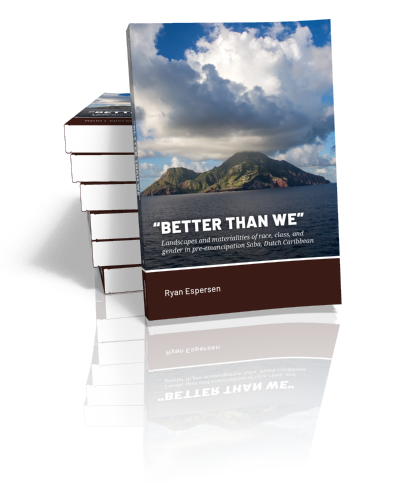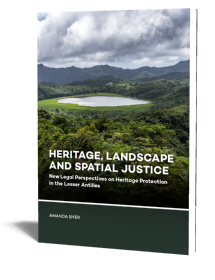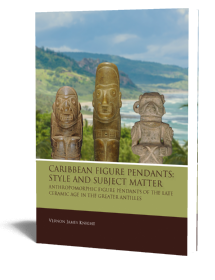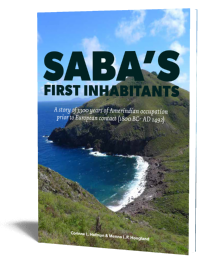“Better Than We”
Landscapes and materialities of race, class, and gender in pre-emancipation Saba, Dutch Caribbean
Ryan Espersen | 2024

“Better Than We”
Landscapes and materialities of race, class, and gender in pre-emancipation Saba, Dutch Caribbean
Ryan Espersen | 2024
Paperback ISBN: 9789464270785 | Hardback ISBN: 9789464270792 | Imprint: Sidestone Press Academics | Format: 182x257mm | 406 pp. | Taboui 8 | Series: Taboui | Language: English | 32 illus. (bw) | 122 illus. (fc) | Keywords: race; class; gender; slavery; poverty; Caribbean; colonial; Dutch; Saba; landscape archaeology; material culture | download cover | DOI: 10.59641/zpw7cwqr
Read online 173 times
- Digital & Online access
-
Buy via Sidestone (EU & UK)
-
Buy via our Distributors (WORLD)
For non-EU or UK destinations you can buy our books via our international distributors. Although prices may vary this will ensure speedy delivery and reduction in shipping costs or import tax. But you can also order with us directly via the module above.
UK international distributor
USA international distributor
-
Bookinfo
Paperback ISBN: 9789464270785 | Hardback ISBN: 9789464270792 | Imprint: Sidestone Press Academics | Format: 182x257mm | 406 pp. | Taboui 8 | Series: Taboui | Language: English | 32 illus. (bw) | 122 illus. (fc) | Keywords: race; class; gender; slavery; poverty; Caribbean; colonial; Dutch; Saba; landscape archaeology; material culture | download cover | DOI: 10.59641/zpw7cwqr
Read online 173 times

We will plant a tree for each order containing a paperback or hardback book via OneTreePlanted.org.
This study aims to understand the materiality of Saba’s ideological landscape during its pre-emancipation colonial period. This is accomplished by understanding the dialectics, or inseparable relationships, between Saba’s geography, locally-situated ideologies of class, race, and gender in Saba’s social environment, and the processes behind these ideological relations that contributed to the material things that are found across Saba’s social landscape.
This provides insights into archaeologies of poverty, approaches towards differentiating between low class and slavery in the archaeological record, and the importance of powered perspectives in defining and situating poverty on local and regional scales.
Acknowledgements
1 Friendly and Lovely, Though Small
Background and approach
The problems with connecting materiality to landscapes, and ideology to materiality
2 The Setting
Positioning research locally
Positioning research regionally
Concluding remarks
3 Theory and Methodology
Ideology
The dialectic
Class
Poverty
Race
Gender
Capitalism as a heuristic device for colonial Saba
The socio-spatial dialectic
Interpretation, sources, and postcolonialsm
A theoretical structure for discerning the social and material vectors of class, race, and gender in pre-emancipation colonial Saba
Closing remarks
4 Saba in the Documentary Record
The sources and their history
Saba during the early colonial period
Saba during the seventeenth century
Saba during the eighteenth century
Saba during the nineteenth century
Saba into the twentieth century
Closing remarks
5 Excavated Plantation Contexts
Fieldwork procedures
Excavation
Finds, features, and soils
Off-site processing of artifacts
Site mapping
SB 004: Spring Bay Sugar and Indigo Plantation
SB 001: Flat Point Sugar and Indigo Plantation
SB 002: Flat Point well
SB 003: Flat Point indigo vats
SB 007: Spring Bay Flat
SB 038: Core Gut Bay
The Bottom sugar plantation
Saban plantations and the acquisition of slave labour
Spatial analysis of sugar plantations as a means for identifying enslaved African housing
Enslaved African dry stone houses in Caribbean contexts
Indigo production on Saba
Closing remarks
6 Excavated Non-Plantation Contexts
SB 037: The Fort Bay ridge site
SB 036: The Bottom privy pit
SB 027: Palmetto Point
SB 026: Middle Island
SB 039: Upper Hell’s Gate animal shelter
SB 022: Little Rendezvouz
SB 050: Thais Hill trash pit
SB 025: Cow Pasture village cistern
Closing remarks
7 Interpreting Race, Class, and Gender in Saba’s Domestic Spaces and Material Culture
Housing, domestic architecture, and cisterns
“The House”, class, and Saban culture
Material culture in eighteenth and nineteenth-century Saba
Diet
Burial practices
8 The Social and Material Vectors of Race, Class, and Gender in pre-Emancipation Colonial Saba
Seascapes, landscapes, and the “incomplete hegemony”
Landscapes of class
Landscapes of race
Landscapes of gender
Class in pre-emancipation colonial Saba
Race and slavery in pre-emancipation colonial Saba
Gender in pre-emancipation colonial Saba
Interpreting Saba’s landscapes of race, class, and gender in its pre-emancipation colonial archaeology
Differentiating between poverty, slavery, and low class in pre-emancipation colonial Saba
Perspectives of landscapes and poverties
Closing remarks
References
Appendices
Tables
Spring Bay boiling house
Flat Point boiling house
Spring Bay Flat boiling house
English summary
Samenvatting
Curriculum Vitae
Dr. Ryan Espersen
Ryan Espersen is an historical archaeologist, cultural heritage consultant, and public educator. Following his Research Masters in Archaeology at Leiden University in 2009, he obtained a Bachelor of Education (2011) to teach high school on the island of Saba, Dutch Caribbean as a means to start a local archaeological education program for both youth and adult residents. He co-founded the Saba Archaeology Center (SABARC) on Saba in 2012 and with government and NGO support, it expanded to include an archaeology office, lab, and museum. In 2012 he joined the European Transatlantic Slave Trade (EUROTAST) research group as a Marie Sklodowska-Curie early stage researcher for his PhD, hosted by Leiden University. He obtained his PhD in 2017 and have been consulting in heritage management and archaeology across the Netherlands and north-eastern Caribbean.
He is currently a Marie Sklodowska-Curie fellow at the University of Cambridge, as the experienced researcher for project “No dollar too dark: free trade, piracy, privateering and illegal slave trading in the northeast Caribbean, early 19th century’”.
Abstract:
This study aims to understand the materiality of Saba’s ideological landscape during its pre-emancipation colonial period. This is accomplished by understanding the dialectics, or inseparable relationships, between Saba’s geography, locally-situated ideologies of class, race, and gender in Saba’s social environment, and the processes behind these ideological relations that contributed to the material things that are found across Saba’s social landscape.
This provides insights into archaeologies of poverty, approaches towards differentiating between low class and slavery in the archaeological record, and the importance of powered perspectives in defining and situating poverty on local and regional scales.
Contents
Acknowledgements
1 Friendly and Lovely, Though Small
Background and approach
The problems with connecting materiality to landscapes, and ideology to materiality
2 The Setting
Positioning research locally
Positioning research regionally
Concluding remarks
3 Theory and Methodology
Ideology
The dialectic
Class
Poverty
Race
Gender
Capitalism as a heuristic device for colonial Saba
The socio-spatial dialectic
Interpretation, sources, and postcolonialsm
A theoretical structure for discerning the social and material vectors of class, race, and gender in pre-emancipation colonial Saba
Closing remarks
4 Saba in the Documentary Record
The sources and their history
Saba during the early colonial period
Saba during the seventeenth century
Saba during the eighteenth century
Saba during the nineteenth century
Saba into the twentieth century
Closing remarks
5 Excavated Plantation Contexts
Fieldwork procedures
Excavation
Finds, features, and soils
Off-site processing of artifacts
Site mapping
SB 004: Spring Bay Sugar and Indigo Plantation
SB 001: Flat Point Sugar and Indigo Plantation
SB 002: Flat Point well
SB 003: Flat Point indigo vats
SB 007: Spring Bay Flat
SB 038: Core Gut Bay
The Bottom sugar plantation
Saban plantations and the acquisition of slave labour
Spatial analysis of sugar plantations as a means for identifying enslaved African housing
Enslaved African dry stone houses in Caribbean contexts
Indigo production on Saba
Closing remarks
6 Excavated Non-Plantation Contexts
SB 037: The Fort Bay ridge site
SB 036: The Bottom privy pit
SB 027: Palmetto Point
SB 026: Middle Island
SB 039: Upper Hell’s Gate animal shelter
SB 022: Little Rendezvouz
SB 050: Thais Hill trash pit
SB 025: Cow Pasture village cistern
Closing remarks
7 Interpreting Race, Class, and Gender in Saba’s Domestic Spaces and Material Culture
Housing, domestic architecture, and cisterns
“The House”, class, and Saban culture
Material culture in eighteenth and nineteenth-century Saba
Diet
Burial practices
8 The Social and Material Vectors of Race, Class, and Gender in pre-Emancipation Colonial Saba
Seascapes, landscapes, and the “incomplete hegemony”
Landscapes of class
Landscapes of race
Landscapes of gender
Class in pre-emancipation colonial Saba
Race and slavery in pre-emancipation colonial Saba
Gender in pre-emancipation colonial Saba
Interpreting Saba’s landscapes of race, class, and gender in its pre-emancipation colonial archaeology
Differentiating between poverty, slavery, and low class in pre-emancipation colonial Saba
Perspectives of landscapes and poverties
Closing remarks
References
Appendices
Tables
Spring Bay boiling house
Flat Point boiling house
Spring Bay Flat boiling house
English summary
Samenvatting
Curriculum Vitae
Dr. Ryan Espersen
Ryan Espersen is an historical archaeologist, cultural heritage consultant, and public educator. Following his Research Masters in Archaeology at Leiden University in 2009, he obtained a Bachelor of Education (2011) to teach high school on the island of Saba, Dutch Caribbean as a means to start a local archaeological education program for both youth and adult residents. He co-founded the Saba Archaeology Center (SABARC) on Saba in 2012 and with government and NGO support, it expanded to include an archaeology office, lab, and museum. In 2012 he joined the European Transatlantic Slave Trade (EUROTAST) research group as a Marie Sklodowska-Curie early stage researcher for his PhD, hosted by Leiden University. He obtained his PhD in 2017 and have been consulting in heritage management and archaeology across the Netherlands and north-eastern Caribbean.
He is currently a Marie Sklodowska-Curie fellow at the University of Cambridge, as the experienced researcher for project “No dollar too dark: free trade, piracy, privateering and illegal slave trading in the northeast Caribbean, early 19th century’”.
- Digital & Online access
-
Buy via Sidestone (EU & UK)
-
Buy via our Distributors (WORLD)
For non-EU or UK destinations you can buy our books via our international distributors. Although prices may vary this will ensure speedy delivery and reduction in shipping costs or import tax. But you can also order with us directly via the module above.
UK international distributor
USA international distributor
- Browse all books by subject
-
Search all books

We will plant a tree for each order containing a paperback or hardback book via OneTreePlanted.org.
You might also like:
© 2025 Sidestone Press KvK nr. 28114891 Privacy policy Sidestone Newsletter Terms and Conditions (Dutch)








